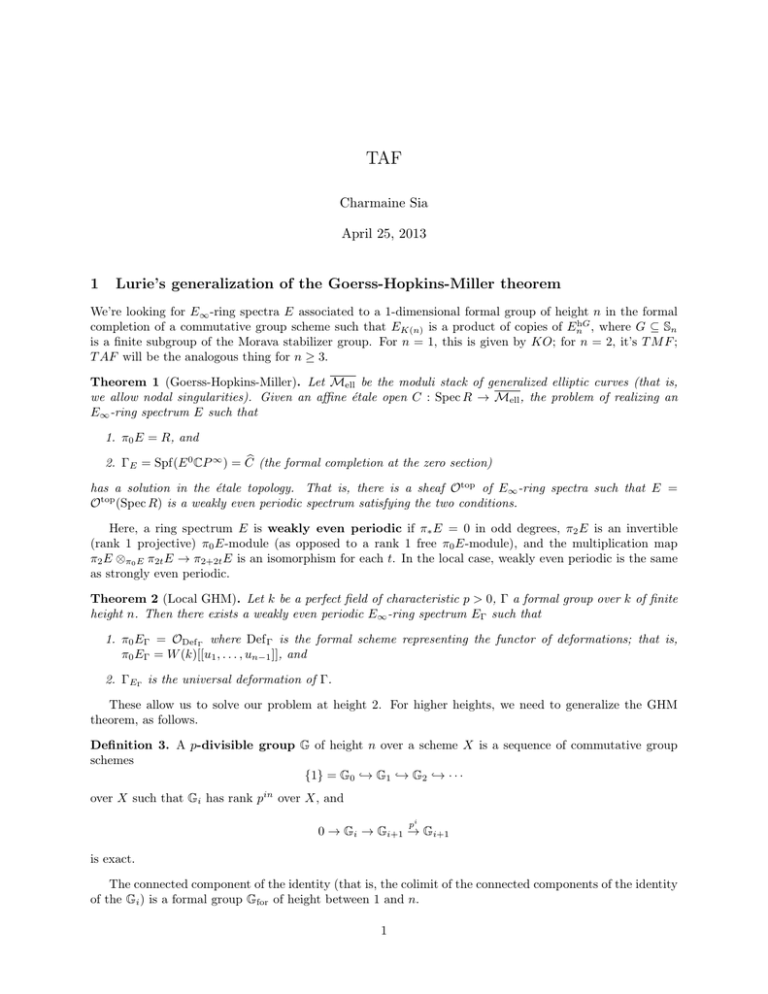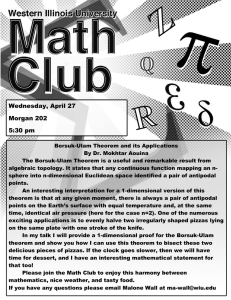TAF 1 Lurie’s generalization of the Goerss-Hopkins-Miller theorem Charmaine Sia
advertisement

TAF
Charmaine Sia
April 25, 2013
1
Lurie’s generalization of the Goerss-Hopkins-Miller theorem
We’re looking for E∞ -ring spectra E associated to a 1-dimensional formal group of height n in the formal
completion of a commutative group scheme such that EK(n) is a product of copies of EnhG , where G ⊆ Sn
is a finite subgroup of the Morava stabilizer group. For n = 1, this is given by KO; for n = 2, it’s T M F ;
T AF will be the analogous thing for n ≥ 3.
Theorem 1 (Goerss-Hopkins-Miller). Let Mell be the moduli stack of generalized elliptic curves (that is,
we allow nodal singularities). Given an affine étale open C : Spec R → Mell , the problem of realizing an
E∞ -ring spectrum E such that
1. π0 E = R, and
b (the formal completion at the zero section)
2. ΓE = Spf(E 0 CP ∞ ) = C
has a solution in the étale topology. That is, there is a sheaf Otop of E∞ -ring spectra such that E =
Otop (Spec R) is a weakly even periodic spectrum satisfying the two conditions.
Here, a ring spectrum E is weakly even periodic if π∗ E = 0 in odd degrees, π2 E is an invertible
(rank 1 projective) π0 E-module (as opposed to a rank 1 free π0 E-module), and the multiplication map
π2 E ⊗π0 E π2t E → π2+2t E is an isomorphism for each t. In the local case, weakly even periodic is the same
as strongly even periodic.
Theorem 2 (Local GHM). Let k be a perfect field of characteristic p > 0, Γ a formal group over k of finite
height n. Then there exists a weakly even periodic E∞ -ring spectrum EΓ such that
1. π0 EΓ = ODef Γ where Def Γ is the formal scheme representing the functor of deformations; that is,
π0 EΓ = W (k)[[u1 , . . . , un−1 ]], and
2. ΓEΓ is the universal deformation of Γ.
These allow us to solve our problem at height 2. For higher heights, we need to generalize the GHM
theorem, as follows.
Definition 3. A p-divisible group G of height n over a scheme X is a sequence of commutative group
schemes
{1} = G0 ,→ G1 ,→ G2 ,→ · · ·
over X such that Gi has rank pin over X, and
pi
0 → Gi → Gi+1 → Gi+1
is exact.
The connected component of the identity (that is, the colimit of the connected components of the identity
of the Gi ) is a formal group Gfor of height between 1 and n.
1
2
Theorem 4 (Lurie). Let (A, m) be a local ring with perfect residue field k of characteristic p, X a locally
noetherian separated Deligne-Mumford stack over Spec A, and G a p-divisible group of constant height n and
dimension 1 over X. Then given a formal affine étale open f : Spf R → X∧
mA , the problem of realizing an
E∞ -ring spectrum E such that
1. π0 E = R, and
2. ΓE = Spf(E 0 CP ∞ ) = f ∗ Gfor (the formal completion at the zero section)
has a solution in the étale topology. That is, there is a sheaf EG of E∞ -ring spectra such that E = EG (Spf R)
is a weakly even periodic spectrum satisfying the two conditions, provided the following condition is satisfied:
∧
, the map Xx∧ → Def π∗ Gx
• for some étale cover π : X → X for X a scheme, and for every point x ∈ Xm
A
∗
classifying (π∗ G)|Xx∧ of π Gx is an isomorphism.
We’d like to use this theorem to produce TAF. We can achieve our goal if the following two conditions
are satisfied:
1. the objects that X parametrizes should have canonical p-divisible groups attached to them, and
2. the local geometry of the stack X should correspond to the deformations of G (as expressed in the
bulleted condition of Lurie’s theorem).
An n-dimensional abelian scheme has a p-divisible group A(p) = {A[pi ]} of height 2n and dimension n,
where A[pi ] is the pi -torsion in A. To achieve condition 1, we need a way to cut down A(p) to have dimension
1, since we only really understand 1-dimensional formal groups. The approach of Gorbunov-MahowaldRavenel is to assume that there are endomorphisms of A splitting off a 1-dimensional summand. For condition
2, given a deformation of a 1-dimensional summand, we can complete it uniquely to a deformation of A.
Half of this is the Serre-Tate theorem.
2
PEL Shimura varieties
Shimura varieties are higher-dimensional analogues of modular curves, which are moduli spaces of elliptic curves. Thus, they are moduli spaces of other sorts of abelian varieties. To get a nice moduli stack,
we need additional structure on the abelian varieties, which we abbreviate by P (for polarization), E (for
endomorphism structure), and L (for level structure). It’s best to remember these by what they do topologically, rather than by their algebro-geometric definitions. The endomorphism structure provides the desired
1-dimensional summand of A(p); the polarization ensures that its height is n and ensures the summand
controls the whole of A(p); and the polarization and the level structure together are used to cut down the
number of connected components of the moduli stack to a finite number.
Let F be an imaginary quadratic extension of Q with ring of integers OF such that p splits in F , which
means that OF ⊗Zp = Zp ×Zp . Let e be an idempotent in OF ⊗Zp not equal to 0 or 1. Complex conjugation
takes e to 1 − e. Consider the functor χ from the category of locally noetherian formal schemes over Spf Zp
to the category of groupoids, with the objects of χ(X) given by the set of quadruples (A, λ, i, η) with
• A an abelian variety over X of dimension n.
• λ : A → A∨ = Pic0 (A) a prime-to-p polarization, i.e. symmetric isogeny arising from a very ample
line bundle. ‘Symmetric’ means that λ = λ∨ ; ‘isogeny’ means that λ is a surjection with finite kernel;
‘prime-to-p’ means that the rank of this kernel is prime to p.
• i : OF → End(A) is a map such that λi(α) = i(α)∨ λ for all α ∈ OF .
• η is a level structure,
which we won’t discuss in detail, but it’s the orbit of something under some
Q
subgroup K p ≤ `6=p Aut(Z⊕2n
).
`
2. PEL SHIMURA VARIETIES
3
The morphisms of χ(X) are the isomorphisms of abelian varieties preserving the level structure, commuting
with i, and with f ∨ λA f = mλA for some m ∈ Z.
The endomorphism structure is defined as follows. First, End(A(p)) is p-complete, so it’s a Zp -algebra.
We get maps
i
/ End A
/ End A(p)
OF
8
$
OF ⊗ Zp .
Recall that e is a nontrivial idempotent in OF ⊗Zp ; this gives a summand eA(p), which Gorbunov-MahowaldRavenel assume is 1-dimensional. (Note that we don’t know its height yet.)
∼
=
The polarization is a prime-to-p isogeny, so it induces an isomorphism A(p) → A∨ (p). We have λe =
(1 − e∨ )λ. Thus λ breaks up into isomorphisms eA(p) = ((1 − e)A(p))∨ and (1 − e)A(p) = (eA(p))∨ . It
follows that a deformation of eA(p) gives a deformation of (1 − e)A(p), and these combine to a deformation
of A(p), which by the Serre-Tate theorem gives a deformation of A.
Finally, taking duals preserves height and height is additive, so since A(p) has height 2n, eA(p) has height
n, as desired. (We won’t discuss the level structure here.)
Theorem 5. The functor χ is representable by a stack Sh(K p ) of dimension n − 1 over Spf Zp . If K p is
sufficiently small, then this stack is actually a quasiprojective scheme.
We can now apply Lurie’s theorem, with Sh(K p ) as our stack. This gives us a sheaf EG , and we can make
the following definition.
Definition 6. The spectrum T AF is the global sections EG (Sh(K p )∧
p ). Evaluating at an affine open U =
⊗k/2
Spf R, we have πk EG (U ) = 0 for k odd and H 0 (U, ωf ∗ Gfor ) for k even. There is a similar descent spectral
sequence as for T M F .





